Aged Care Practices in Australia: Models, Issues, and Critiques
VerifiedAdded on 2022/09/06
|8
|1850
|19
Report
AI Summary
This report delves into aged care practices within the Australian context, addressing several key aspects of service delivery. It begins by examining strategies designed to promote independence and social participation among older adults, weighing both positive and negative factors. The report then explains a specific model of health service delivery in aged care, providing a detailed understanding of its framework and components. Following this, the report offers a critical analysis of the chosen health service delivery model, identifying strengths, weaknesses, and areas for improvement. Furthermore, it explores the political and ethical issues surrounding a user contribution system in aged care, discussing the implications of such a system on access, equity, and the overall quality of care. The report concludes by referencing relevant literature to support its arguments and provide a comprehensive overview of the subject matter.
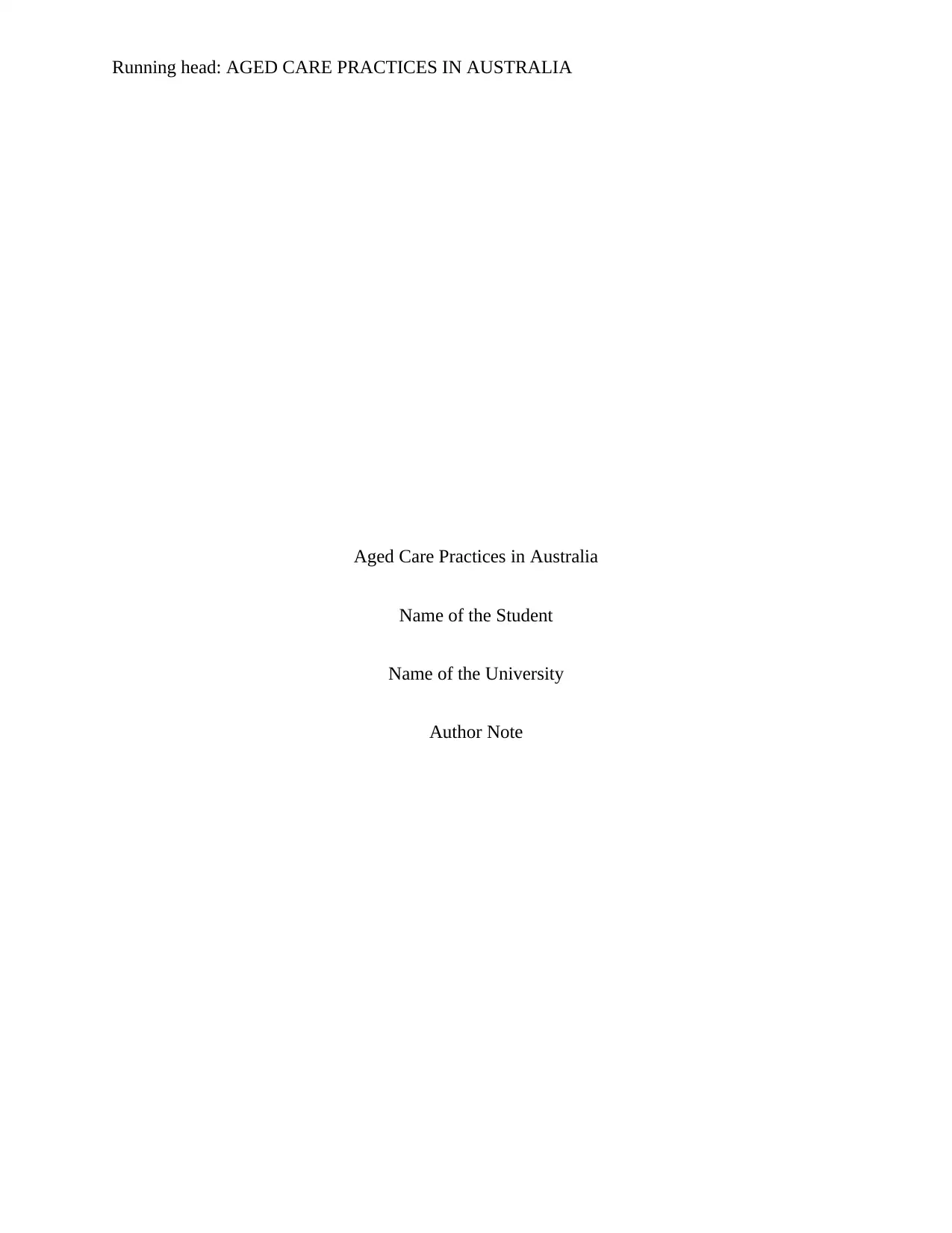
Running head: AGED CARE PRACTICES IN AUSTRALIA
Aged Care Practices in Australia
Name of the Student
Name of the University
Author Note
Aged Care Practices in Australia
Name of the Student
Name of the University
Author Note
Paraphrase This Document
Need a fresh take? Get an instant paraphrase of this document with our AI Paraphraser
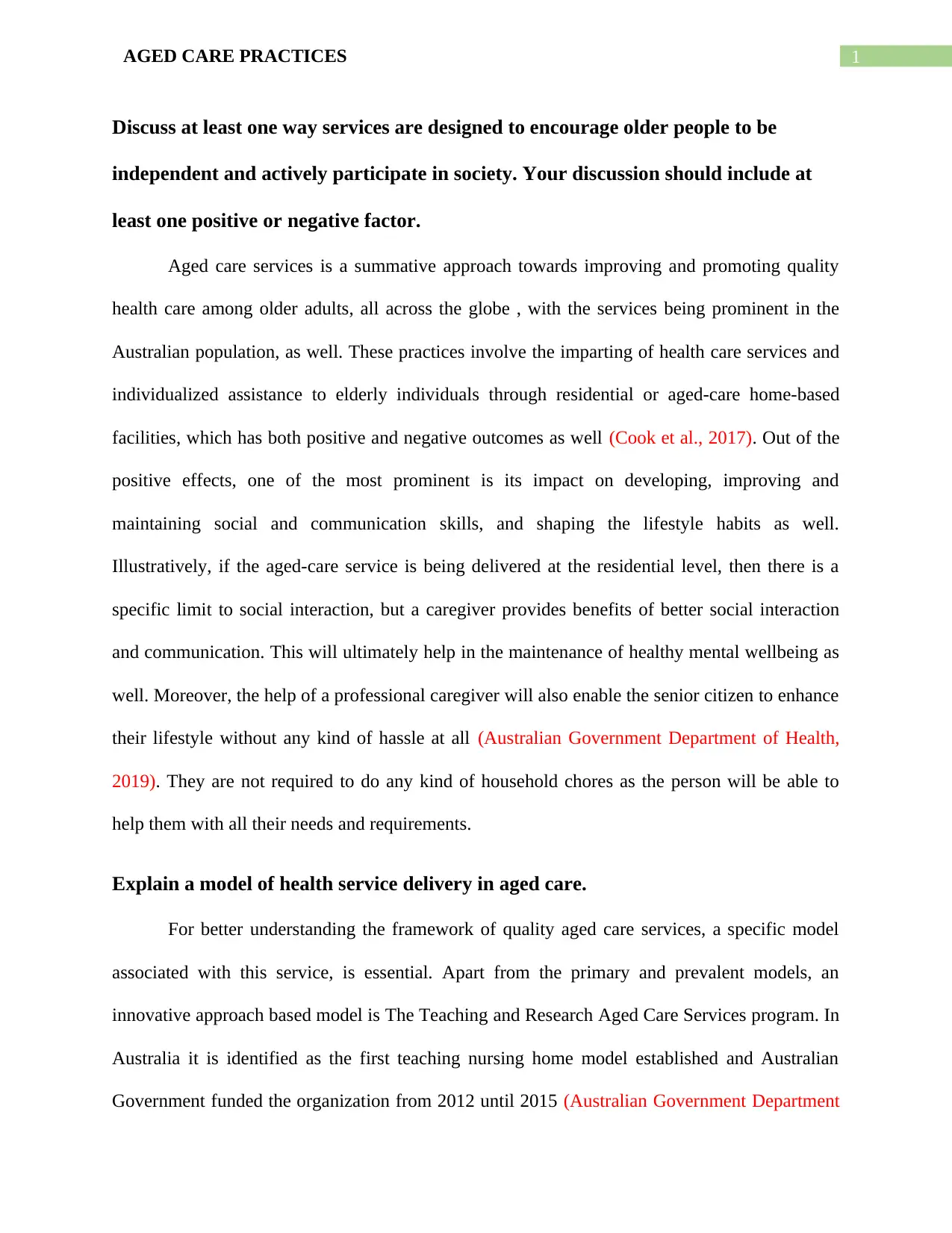
1AGED CARE PRACTICES
Discuss at least one way services are designed to encourage older people to be
independent and actively participate in society. Your discussion should include at
least one positive or negative factor.
Aged care services is a summative approach towards improving and promoting quality
health care among older adults, all across the globe , with the services being prominent in the
Australian population, as well. These practices involve the imparting of health care services and
individualized assistance to elderly individuals through residential or aged-care home-based
facilities, which has both positive and negative outcomes as well (Cook et al., 2017). Out of the
positive effects, one of the most prominent is its impact on developing, improving and
maintaining social and communication skills, and shaping the lifestyle habits as well.
Illustratively, if the aged-care service is being delivered at the residential level, then there is a
specific limit to social interaction, but a caregiver provides benefits of better social interaction
and communication. This will ultimately help in the maintenance of healthy mental wellbeing as
well. Moreover, the help of a professional caregiver will also enable the senior citizen to enhance
their lifestyle without any kind of hassle at all (Australian Government Department of Health,
2019). They are not required to do any kind of household chores as the person will be able to
help them with all their needs and requirements.
Explain a model of health service delivery in aged care.
For better understanding the framework of quality aged care services, a specific model
associated with this service, is essential. Apart from the primary and prevalent models, an
innovative approach based model is The Teaching and Research Aged Care Services program. In
Australia it is identified as the first teaching nursing home model established and Australian
Government funded the organization from 2012 until 2015 (Australian Government Department
Discuss at least one way services are designed to encourage older people to be
independent and actively participate in society. Your discussion should include at
least one positive or negative factor.
Aged care services is a summative approach towards improving and promoting quality
health care among older adults, all across the globe , with the services being prominent in the
Australian population, as well. These practices involve the imparting of health care services and
individualized assistance to elderly individuals through residential or aged-care home-based
facilities, which has both positive and negative outcomes as well (Cook et al., 2017). Out of the
positive effects, one of the most prominent is its impact on developing, improving and
maintaining social and communication skills, and shaping the lifestyle habits as well.
Illustratively, if the aged-care service is being delivered at the residential level, then there is a
specific limit to social interaction, but a caregiver provides benefits of better social interaction
and communication. This will ultimately help in the maintenance of healthy mental wellbeing as
well. Moreover, the help of a professional caregiver will also enable the senior citizen to enhance
their lifestyle without any kind of hassle at all (Australian Government Department of Health,
2019). They are not required to do any kind of household chores as the person will be able to
help them with all their needs and requirements.
Explain a model of health service delivery in aged care.
For better understanding the framework of quality aged care services, a specific model
associated with this service, is essential. Apart from the primary and prevalent models, an
innovative approach based model is The Teaching and Research Aged Care Services program. In
Australia it is identified as the first teaching nursing home model established and Australian
Government funded the organization from 2012 until 2015 (Australian Government Department
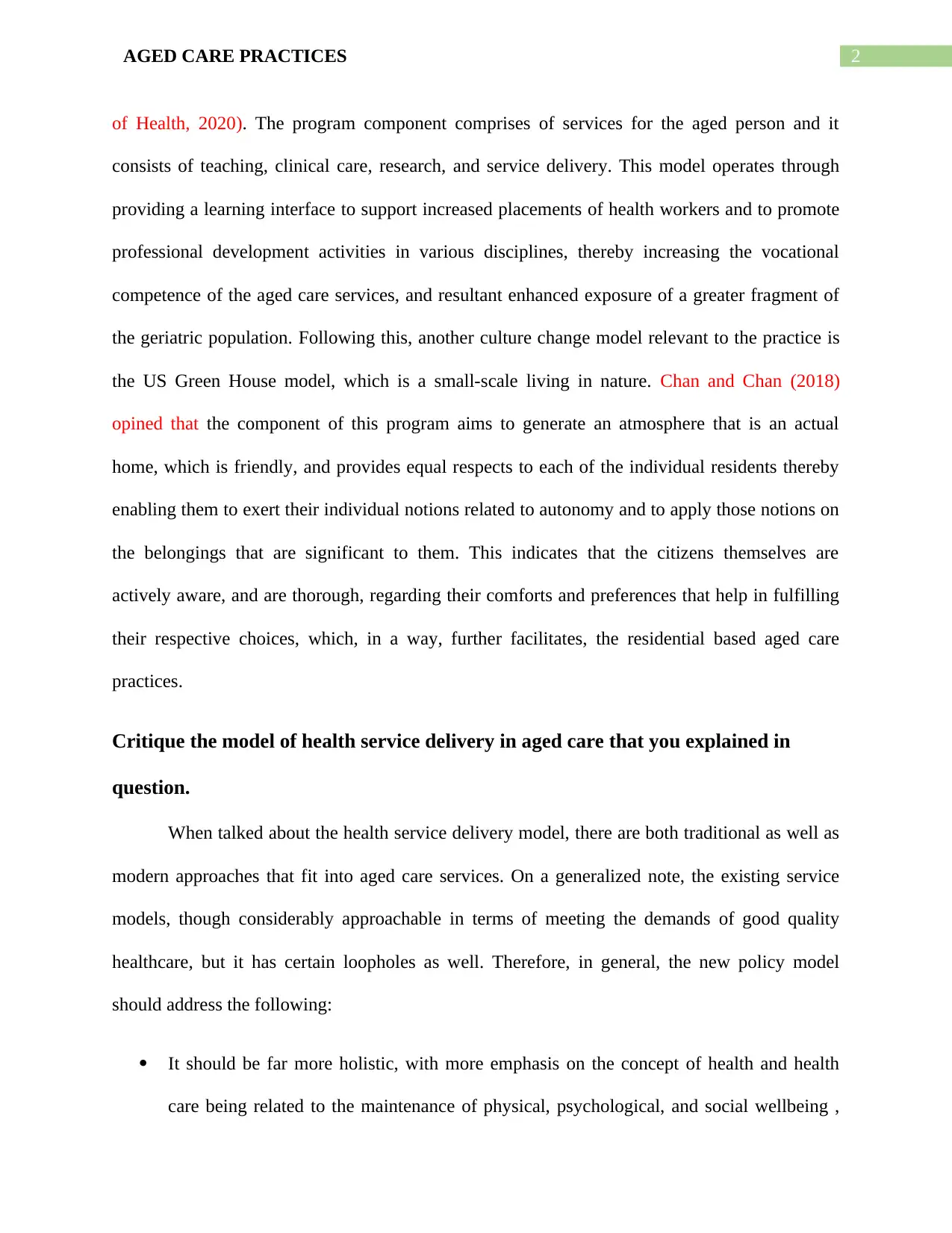
2AGED CARE PRACTICES
of Health, 2020). The program component comprises of services for the aged person and it
consists of teaching, clinical care, research, and service delivery. This model operates through
providing a learning interface to support increased placements of health workers and to promote
professional development activities in various disciplines, thereby increasing the vocational
competence of the aged care services, and resultant enhanced exposure of a greater fragment of
the geriatric population. Following this, another culture change model relevant to the practice is
the US Green House model, which is a small-scale living in nature. Chan and Chan (2018)
opined that the component of this program aims to generate an atmosphere that is an actual
home, which is friendly, and provides equal respects to each of the individual residents thereby
enabling them to exert their individual notions related to autonomy and to apply those notions on
the belongings that are significant to them. This indicates that the citizens themselves are
actively aware, and are thorough, regarding their comforts and preferences that help in fulfilling
their respective choices, which, in a way, further facilitates, the residential based aged care
practices.
Critique the model of health service delivery in aged care that you explained in
question.
When talked about the health service delivery model, there are both traditional as well as
modern approaches that fit into aged care services. On a generalized note, the existing service
models, though considerably approachable in terms of meeting the demands of good quality
healthcare, but it has certain loopholes as well. Therefore, in general, the new policy model
should address the following:
It should be far more holistic, with more emphasis on the concept of health and health
care being related to the maintenance of physical, psychological, and social wellbeing ,
of Health, 2020). The program component comprises of services for the aged person and it
consists of teaching, clinical care, research, and service delivery. This model operates through
providing a learning interface to support increased placements of health workers and to promote
professional development activities in various disciplines, thereby increasing the vocational
competence of the aged care services, and resultant enhanced exposure of a greater fragment of
the geriatric population. Following this, another culture change model relevant to the practice is
the US Green House model, which is a small-scale living in nature. Chan and Chan (2018)
opined that the component of this program aims to generate an atmosphere that is an actual
home, which is friendly, and provides equal respects to each of the individual residents thereby
enabling them to exert their individual notions related to autonomy and to apply those notions on
the belongings that are significant to them. This indicates that the citizens themselves are
actively aware, and are thorough, regarding their comforts and preferences that help in fulfilling
their respective choices, which, in a way, further facilitates, the residential based aged care
practices.
Critique the model of health service delivery in aged care that you explained in
question.
When talked about the health service delivery model, there are both traditional as well as
modern approaches that fit into aged care services. On a generalized note, the existing service
models, though considerably approachable in terms of meeting the demands of good quality
healthcare, but it has certain loopholes as well. Therefore, in general, the new policy model
should address the following:
It should be far more holistic, with more emphasis on the concept of health and health
care being related to the maintenance of physical, psychological, and social wellbeing ,
⊘ This is a preview!⊘
Do you want full access?
Subscribe today to unlock all pages.

Trusted by 1+ million students worldwide
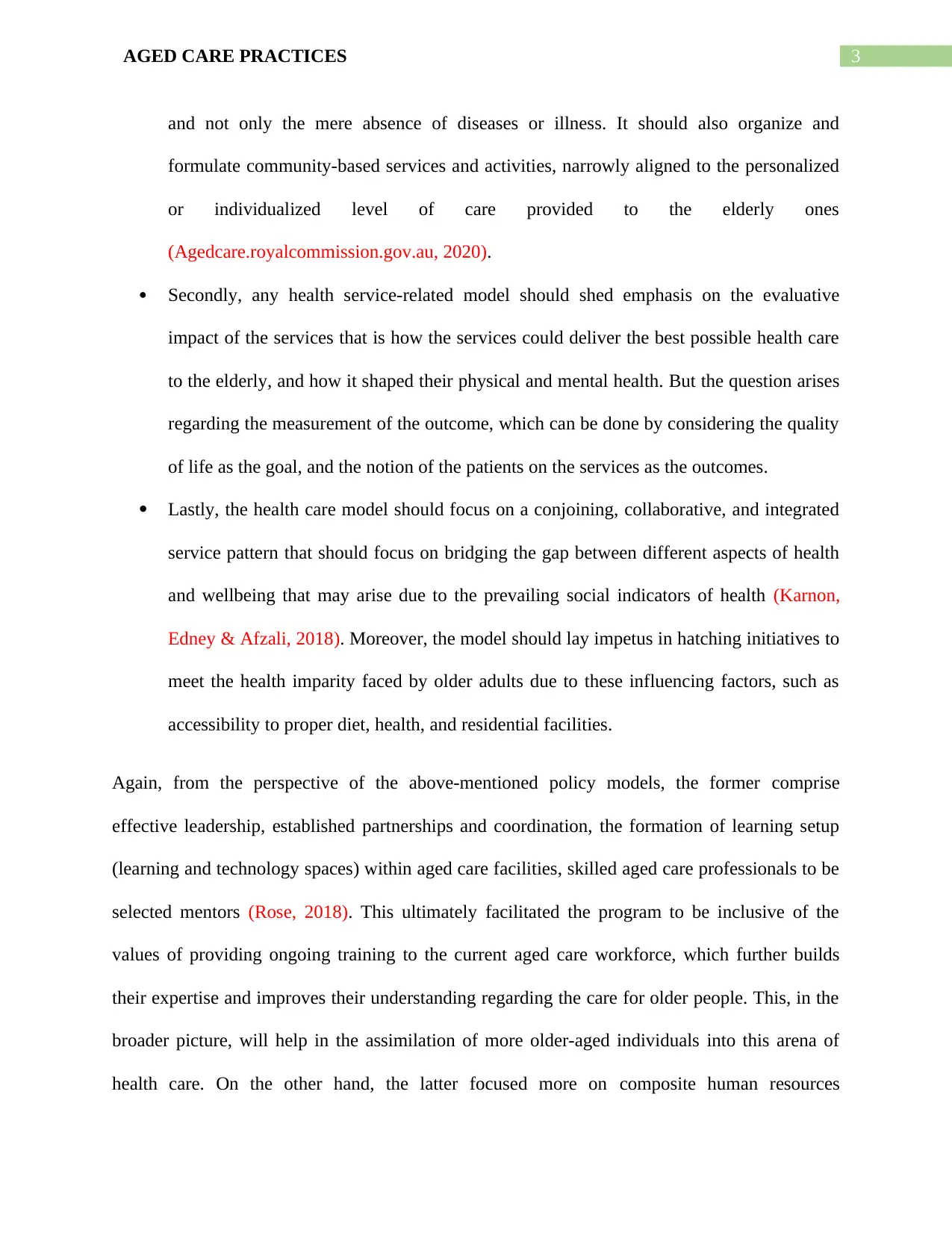
3AGED CARE PRACTICES
and not only the mere absence of diseases or illness. It should also organize and
formulate community-based services and activities, narrowly aligned to the personalized
or individualized level of care provided to the elderly ones
(Agedcare.royalcommission.gov.au, 2020).
Secondly, any health service-related model should shed emphasis on the evaluative
impact of the services that is how the services could deliver the best possible health care
to the elderly, and how it shaped their physical and mental health. But the question arises
regarding the measurement of the outcome, which can be done by considering the quality
of life as the goal, and the notion of the patients on the services as the outcomes.
Lastly, the health care model should focus on a conjoining, collaborative, and integrated
service pattern that should focus on bridging the gap between different aspects of health
and wellbeing that may arise due to the prevailing social indicators of health (Karnon,
Edney & Afzali, 2018). Moreover, the model should lay impetus in hatching initiatives to
meet the health imparity faced by older adults due to these influencing factors, such as
accessibility to proper diet, health, and residential facilities.
Again, from the perspective of the above-mentioned policy models, the former comprise
effective leadership, established partnerships and coordination, the formation of learning setup
(learning and technology spaces) within aged care facilities, skilled aged care professionals to be
selected mentors (Rose, 2018). This ultimately facilitated the program to be inclusive of the
values of providing ongoing training to the current aged care workforce, which further builds
their expertise and improves their understanding regarding the care for older people. This, in the
broader picture, will help in the assimilation of more older-aged individuals into this arena of
health care. On the other hand, the latter focused more on composite human resources
and not only the mere absence of diseases or illness. It should also organize and
formulate community-based services and activities, narrowly aligned to the personalized
or individualized level of care provided to the elderly ones
(Agedcare.royalcommission.gov.au, 2020).
Secondly, any health service-related model should shed emphasis on the evaluative
impact of the services that is how the services could deliver the best possible health care
to the elderly, and how it shaped their physical and mental health. But the question arises
regarding the measurement of the outcome, which can be done by considering the quality
of life as the goal, and the notion of the patients on the services as the outcomes.
Lastly, the health care model should focus on a conjoining, collaborative, and integrated
service pattern that should focus on bridging the gap between different aspects of health
and wellbeing that may arise due to the prevailing social indicators of health (Karnon,
Edney & Afzali, 2018). Moreover, the model should lay impetus in hatching initiatives to
meet the health imparity faced by older adults due to these influencing factors, such as
accessibility to proper diet, health, and residential facilities.
Again, from the perspective of the above-mentioned policy models, the former comprise
effective leadership, established partnerships and coordination, the formation of learning setup
(learning and technology spaces) within aged care facilities, skilled aged care professionals to be
selected mentors (Rose, 2018). This ultimately facilitated the program to be inclusive of the
values of providing ongoing training to the current aged care workforce, which further builds
their expertise and improves their understanding regarding the care for older people. This, in the
broader picture, will help in the assimilation of more older-aged individuals into this arena of
health care. On the other hand, the latter focused more on composite human resources
Paraphrase This Document
Need a fresh take? Get an instant paraphrase of this document with our AI Paraphraser
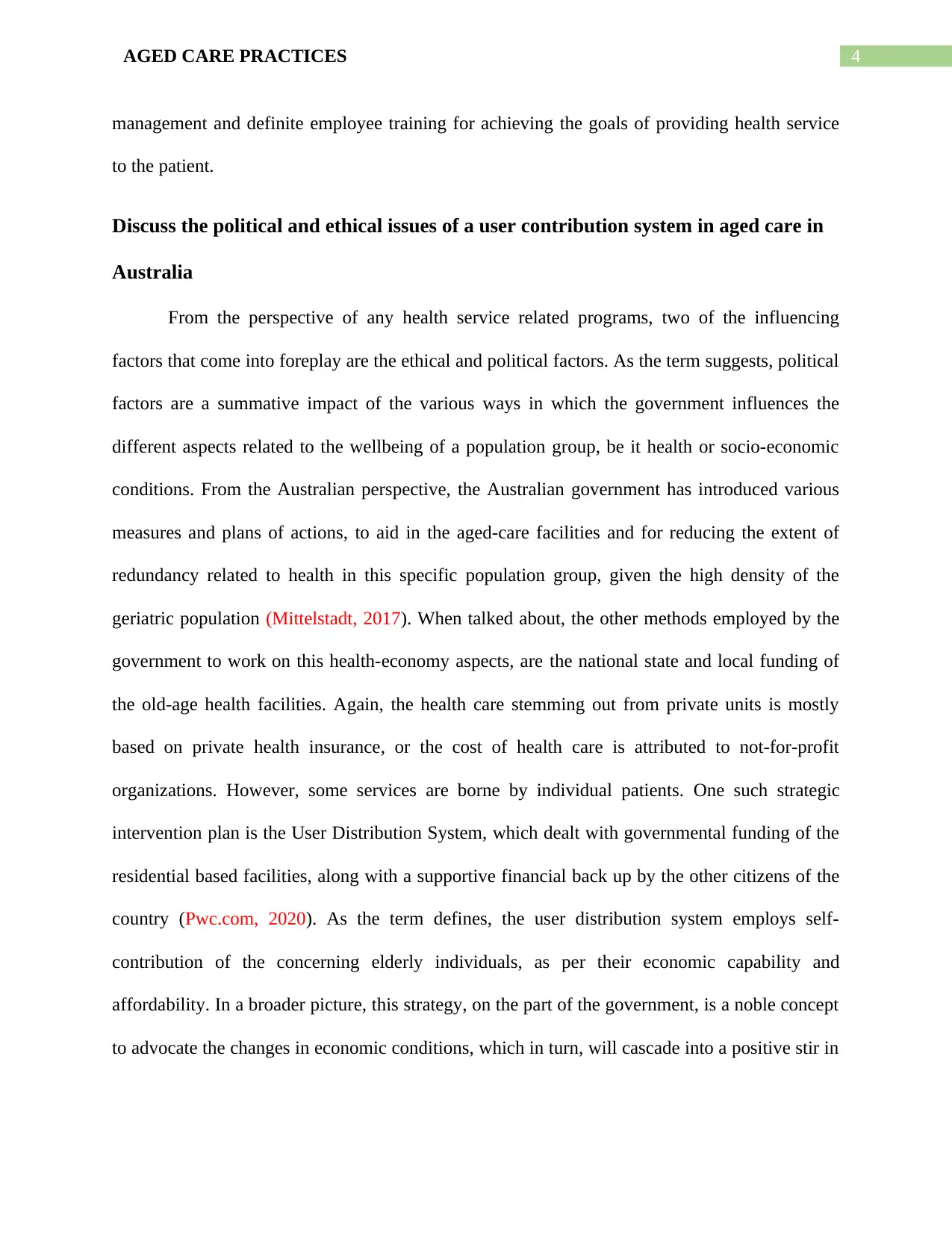
4AGED CARE PRACTICES
management and definite employee training for achieving the goals of providing health service
to the patient.
Discuss the political and ethical issues of a user contribution system in aged care in
Australia
From the perspective of any health service related programs, two of the influencing
factors that come into foreplay are the ethical and political factors. As the term suggests, political
factors are a summative impact of the various ways in which the government influences the
different aspects related to the wellbeing of a population group, be it health or socio-economic
conditions. From the Australian perspective, the Australian government has introduced various
measures and plans of actions, to aid in the aged-care facilities and for reducing the extent of
redundancy related to health in this specific population group, given the high density of the
geriatric population (Mittelstadt, 2017). When talked about, the other methods employed by the
government to work on this health-economy aspects, are the national state and local funding of
the old-age health facilities. Again, the health care stemming out from private units is mostly
based on private health insurance, or the cost of health care is attributed to not-for-profit
organizations. However, some services are borne by individual patients. One such strategic
intervention plan is the User Distribution System, which dealt with governmental funding of the
residential based facilities, along with a supportive financial back up by the other citizens of the
country (Pwc.com, 2020). As the term defines, the user distribution system employs self-
contribution of the concerning elderly individuals, as per their economic capability and
affordability. In a broader picture, this strategy, on the part of the government, is a noble concept
to advocate the changes in economic conditions, which in turn, will cascade into a positive stir in
management and definite employee training for achieving the goals of providing health service
to the patient.
Discuss the political and ethical issues of a user contribution system in aged care in
Australia
From the perspective of any health service related programs, two of the influencing
factors that come into foreplay are the ethical and political factors. As the term suggests, political
factors are a summative impact of the various ways in which the government influences the
different aspects related to the wellbeing of a population group, be it health or socio-economic
conditions. From the Australian perspective, the Australian government has introduced various
measures and plans of actions, to aid in the aged-care facilities and for reducing the extent of
redundancy related to health in this specific population group, given the high density of the
geriatric population (Mittelstadt, 2017). When talked about, the other methods employed by the
government to work on this health-economy aspects, are the national state and local funding of
the old-age health facilities. Again, the health care stemming out from private units is mostly
based on private health insurance, or the cost of health care is attributed to not-for-profit
organizations. However, some services are borne by individual patients. One such strategic
intervention plan is the User Distribution System, which dealt with governmental funding of the
residential based facilities, along with a supportive financial back up by the other citizens of the
country (Pwc.com, 2020). As the term defines, the user distribution system employs self-
contribution of the concerning elderly individuals, as per their economic capability and
affordability. In a broader picture, this strategy, on the part of the government, is a noble concept
to advocate the changes in economic conditions, which in turn, will cascade into a positive stir in
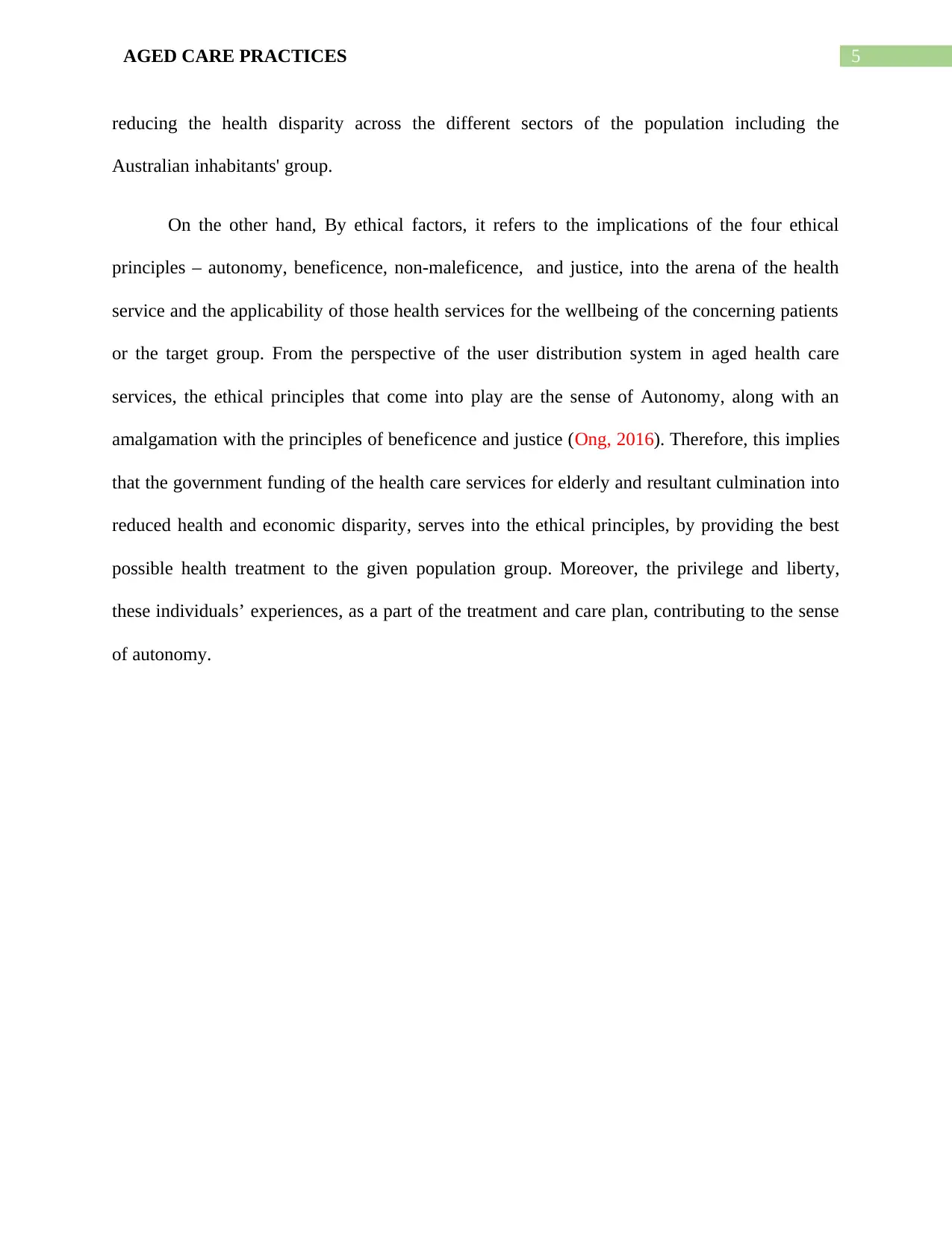
5AGED CARE PRACTICES
reducing the health disparity across the different sectors of the population including the
Australian inhabitants' group.
On the other hand, By ethical factors, it refers to the implications of the four ethical
principles – autonomy, beneficence, non-maleficence, and justice, into the arena of the health
service and the applicability of those health services for the wellbeing of the concerning patients
or the target group. From the perspective of the user distribution system in aged health care
services, the ethical principles that come into play are the sense of Autonomy, along with an
amalgamation with the principles of beneficence and justice (Ong, 2016). Therefore, this implies
that the government funding of the health care services for elderly and resultant culmination into
reduced health and economic disparity, serves into the ethical principles, by providing the best
possible health treatment to the given population group. Moreover, the privilege and liberty,
these individuals’ experiences, as a part of the treatment and care plan, contributing to the sense
of autonomy.
reducing the health disparity across the different sectors of the population including the
Australian inhabitants' group.
On the other hand, By ethical factors, it refers to the implications of the four ethical
principles – autonomy, beneficence, non-maleficence, and justice, into the arena of the health
service and the applicability of those health services for the wellbeing of the concerning patients
or the target group. From the perspective of the user distribution system in aged health care
services, the ethical principles that come into play are the sense of Autonomy, along with an
amalgamation with the principles of beneficence and justice (Ong, 2016). Therefore, this implies
that the government funding of the health care services for elderly and resultant culmination into
reduced health and economic disparity, serves into the ethical principles, by providing the best
possible health treatment to the given population group. Moreover, the privilege and liberty,
these individuals’ experiences, as a part of the treatment and care plan, contributing to the sense
of autonomy.
⊘ This is a preview!⊘
Do you want full access?
Subscribe today to unlock all pages.

Trusted by 1+ million students worldwide
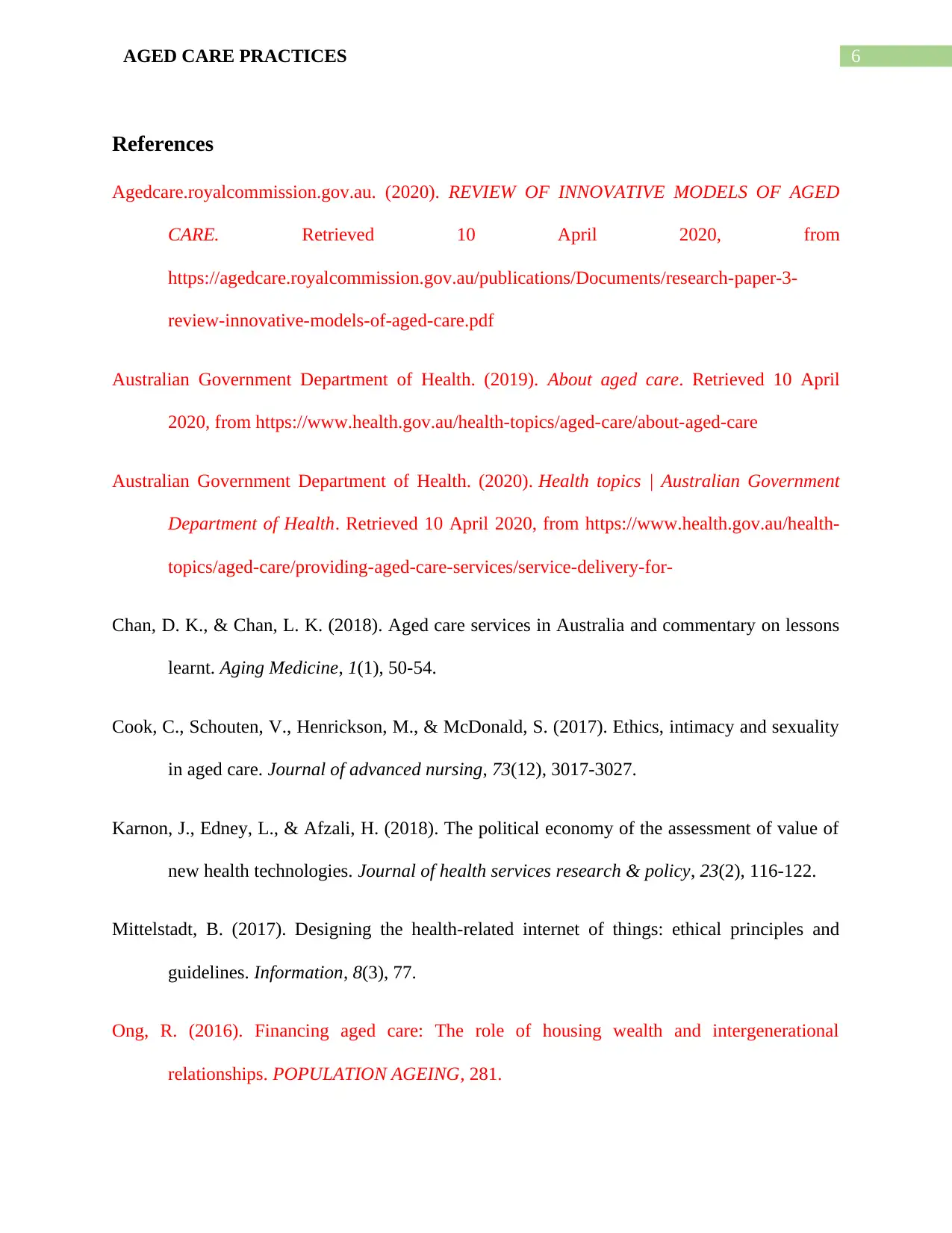
6AGED CARE PRACTICES
References
Agedcare.royalcommission.gov.au. (2020). REVIEW OF INNOVATIVE MODELS OF AGED
CARE. Retrieved 10 April 2020, from
https://agedcare.royalcommission.gov.au/publications/Documents/research-paper-3-
review-innovative-models-of-aged-care.pdf
Australian Government Department of Health. (2019). About aged care. Retrieved 10 April
2020, from https://www.health.gov.au/health-topics/aged-care/about-aged-care
Australian Government Department of Health. (2020). Health topics | Australian Government
Department of Health. Retrieved 10 April 2020, from https://www.health.gov.au/health-
topics/aged-care/providing-aged-care-services/service-delivery-for-
Chan, D. K., & Chan, L. K. (2018). Aged care services in Australia and commentary on lessons
learnt. Aging Medicine, 1(1), 50-54.
Cook, C., Schouten, V., Henrickson, M., & McDonald, S. (2017). Ethics, intimacy and sexuality
in aged care. Journal of advanced nursing, 73(12), 3017-3027.
Karnon, J., Edney, L., & Afzali, H. (2018). The political economy of the assessment of value of
new health technologies. Journal of health services research & policy, 23(2), 116-122.
Mittelstadt, B. (2017). Designing the health-related internet of things: ethical principles and
guidelines. Information, 8(3), 77.
Ong, R. (2016). Financing aged care: The role of housing wealth and intergenerational
relationships. POPULATION AGEING, 281.
References
Agedcare.royalcommission.gov.au. (2020). REVIEW OF INNOVATIVE MODELS OF AGED
CARE. Retrieved 10 April 2020, from
https://agedcare.royalcommission.gov.au/publications/Documents/research-paper-3-
review-innovative-models-of-aged-care.pdf
Australian Government Department of Health. (2019). About aged care. Retrieved 10 April
2020, from https://www.health.gov.au/health-topics/aged-care/about-aged-care
Australian Government Department of Health. (2020). Health topics | Australian Government
Department of Health. Retrieved 10 April 2020, from https://www.health.gov.au/health-
topics/aged-care/providing-aged-care-services/service-delivery-for-
Chan, D. K., & Chan, L. K. (2018). Aged care services in Australia and commentary on lessons
learnt. Aging Medicine, 1(1), 50-54.
Cook, C., Schouten, V., Henrickson, M., & McDonald, S. (2017). Ethics, intimacy and sexuality
in aged care. Journal of advanced nursing, 73(12), 3017-3027.
Karnon, J., Edney, L., & Afzali, H. (2018). The political economy of the assessment of value of
new health technologies. Journal of health services research & policy, 23(2), 116-122.
Mittelstadt, B. (2017). Designing the health-related internet of things: ethical principles and
guidelines. Information, 8(3), 77.
Ong, R. (2016). Financing aged care: The role of housing wealth and intergenerational
relationships. POPULATION AGEING, 281.
Paraphrase This Document
Need a fresh take? Get an instant paraphrase of this document with our AI Paraphraser
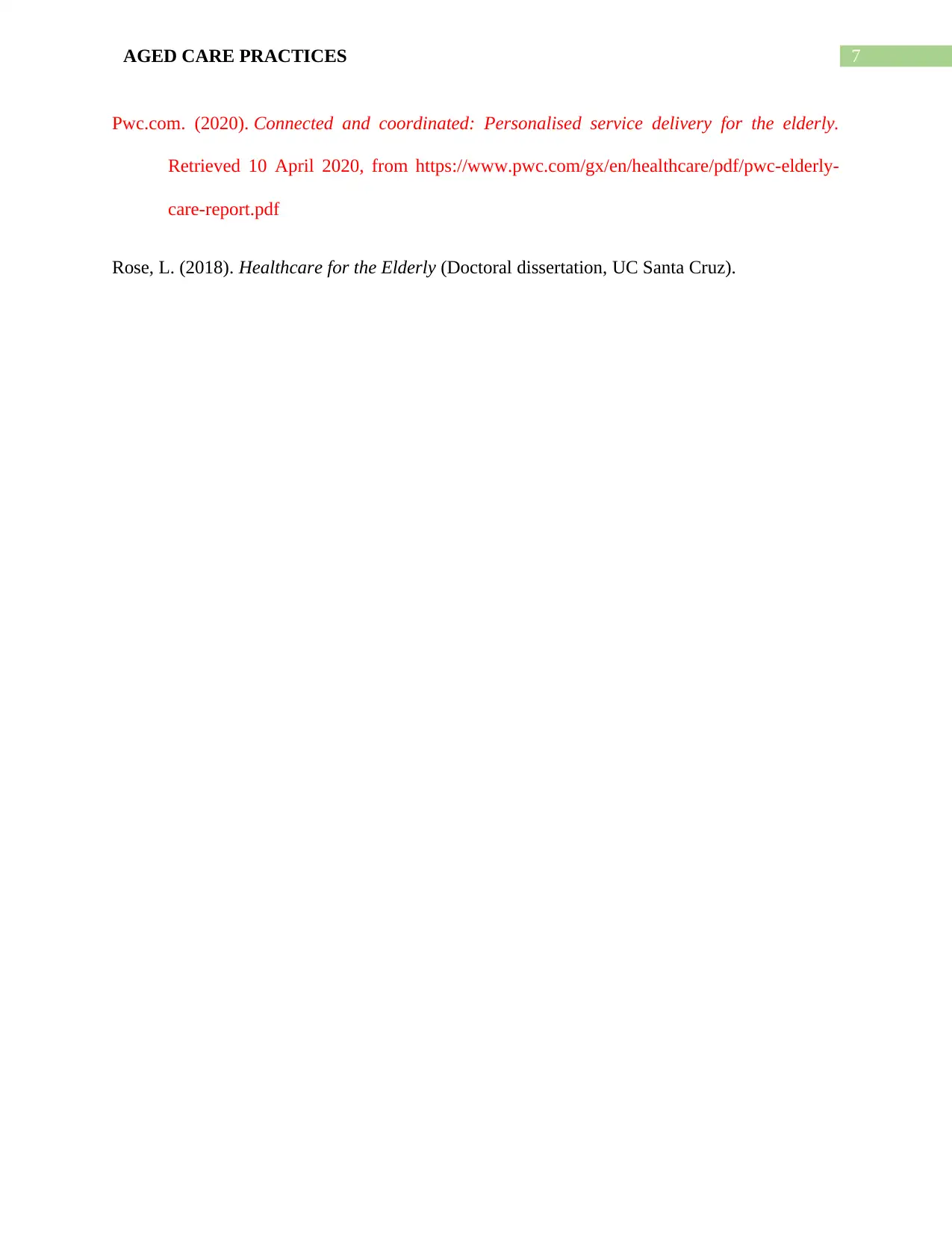
7AGED CARE PRACTICES
Pwc.com. (2020). Connected and coordinated: Personalised service delivery for the elderly.
Retrieved 10 April 2020, from https://www.pwc.com/gx/en/healthcare/pdf/pwc-elderly-
care-report.pdf
Rose, L. (2018). Healthcare for the Elderly (Doctoral dissertation, UC Santa Cruz).
Pwc.com. (2020). Connected and coordinated: Personalised service delivery for the elderly.
Retrieved 10 April 2020, from https://www.pwc.com/gx/en/healthcare/pdf/pwc-elderly-
care-report.pdf
Rose, L. (2018). Healthcare for the Elderly (Doctoral dissertation, UC Santa Cruz).
1 out of 8
Related Documents
Your All-in-One AI-Powered Toolkit for Academic Success.
+13062052269
info@desklib.com
Available 24*7 on WhatsApp / Email
![[object Object]](/_next/static/media/star-bottom.7253800d.svg)
Unlock your academic potential
Copyright © 2020–2025 A2Z Services. All Rights Reserved. Developed and managed by ZUCOL.



